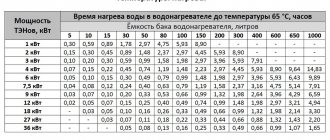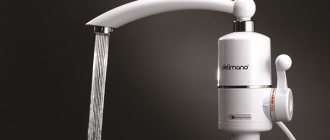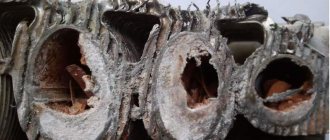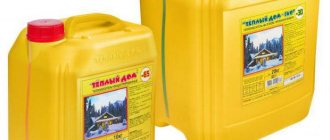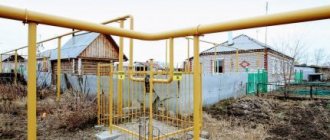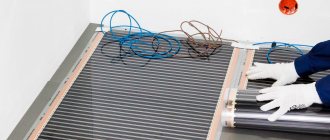Although it is no longer common for global water cut-offs in summer to occur, people in some cities still have to deal with hot water interruptions. The owners of suburban real estate also need to puzzle over how to enjoy all the benefits of civilization, while enjoying nature and fresh air.
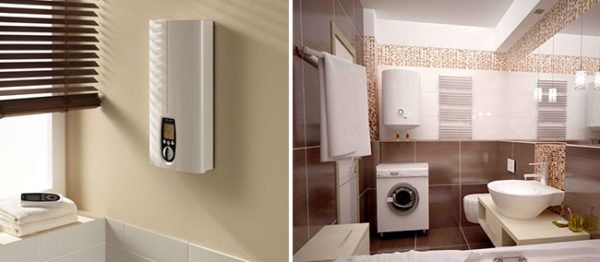
The optimal solution is a water heater. However, if earlier it was possible to choose from just a few models that work on the same principle, today the assortment is more than varied.
Gas or electric water heater
In this matter, everything is pretty simple. The days of gas installations are over. This is not the safest equipment and also requires compliance with established standards. For example, there is SNiP 42-01-2002 (it was adopted instead of 2.04.08-87), which talks about gas distribution systems, there is a point where it says that gas appliances are not recommended to be installed in some rooms. For example, in bathrooms less than 6 m2. Also, a chimney must be present in the room, since the columns are not connected to the hood. There are many other requirements as well.
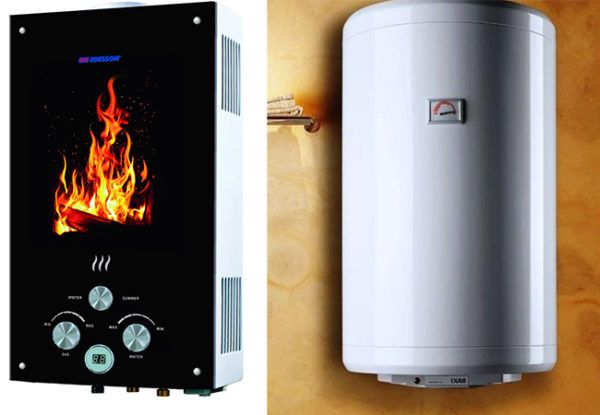

Electric water heaters are more modern systems that are much easier to operate and maintain. However, there are many such models. Before deciding on the main characteristics of boilers, it is worth deciding which type of equipment is better.
Features of the storage water heater
When choosing a storage water heater, you need to pay attention to the number of heating elements and their power indicators, as well as the characteristics of the materials used for the manufacture of the tank, the total capacity of the tank, the installation method and additional functions.
Modern storage water heating devices have the following advantages:
- insignificant power indicators of heating elements, due to which the connection of such a device does not require the laying of too powerful electrical wiring and the allocation of a separate line;
- the efficiency and time of preserving thermal energy is ensured by the thermal insulation characteristics of the storage tank, which allows the use of pre-heated water for a long time;
- the stability of the temperature indicators of the outlet water provided by the built-in thermostat;
- providing with hot water supply several points of water analysis at once with the correct choice of the volume of the storage tank.
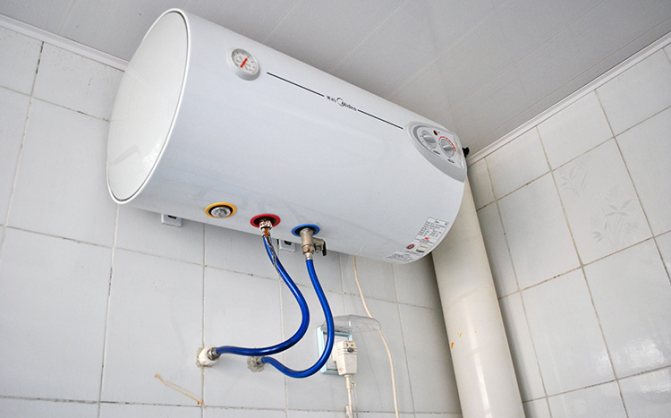

Horizontal storage water heater
The main disadvantages of storage devices for heating water are represented by inertia, impressive dimensions and the lack of economic feasibility in conditions of rare operation. Even the most modern storage models are characterized by excessive consumption of electrical energy, as well as the inability to work in conditions of disconnection of cold water supply for supply.
Storage water heaters of the new generation are equipped with two heating elements, which ensures fast preparation of hot water, efficiency when operating in a special mode, as well as uninterrupted hot water supply in the event of failure of one of the heating elements.
Instantaneous water heater
In this case, we are talking about the direct heating of water, at the moment the tap is turned on. There are three types of instantaneous water heaters:
- Stationary systems.Products are large in volume and require separate installation space.
- Water heaters nozzles. They are installed directly on the crane. It is easy to guess that they are enough only to wash their hands.
- Electrically heated tap. It is a separate mixer. In fact, the water heats up according to the same principle as the nozzles, only faster. This means that the equipment has a higher performance.
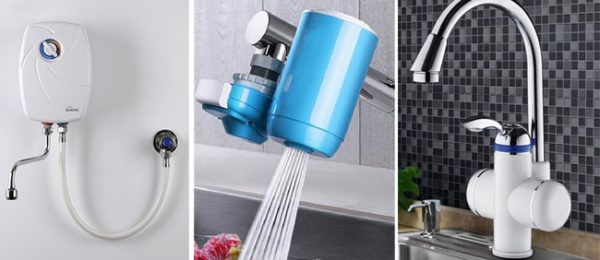

Owners of suburban real estate give such models because of the low cost. But, such heaters have a lot of disadvantages. First of all, they fail much faster. In addition, the flowing power of such units is at least 3 kW. And if you want to take a shower, then the power of such a flume exceeds 10 kW. Not every power grid can handle such loads. For a storage boiler, this parameter ranges from 1.4 to 2.5 kW. Therefore, it is much easier and more profitable to buy this particular type of boiler.
Instantaneous water heater: principle of operation
Unlike a storage device, a flow-through device heats water only during its consumption. It can be gas or electric. For electric flow-through water heaters, there is the following classification:
- open;
- closed;
- pressure head;
- unsupported.
The role of the energy source, depending on the type of device, can be played by:
- tubular electric heater;
- gas-burner;
- solid fuel.
Let's take a closer look at the electric flow heater. It has a small size, which allows the heating element to have time to heat the water passing through it. The free-flow version is designed to meet the needs of one user, and is equipped with either a shower head or a spout.
When the liquid passes through the device, the flow switch directs it to an electric heater that turns on automatically. The automated start-up of the heating element is the explanation for the fact that the flow-through unit heats the water almost instantly. The design nuances allow the device to produce an unlimited volume of water heated to a certain temperature.
The controls can be hydraulic or electronic. Models with the latter type of control have significantly higher efficiency. In addition, they can automatically maintain the outlet temperature - the head is irrelevant.
In an open water heater, water is heated due to its direct contact with the heating element. In a closed one, the liquid and the electric heater do not touch, and the water heats up, passing through copper or brass pipes. Although such a device consumes less energy, it is less efficient than an open one.
pros
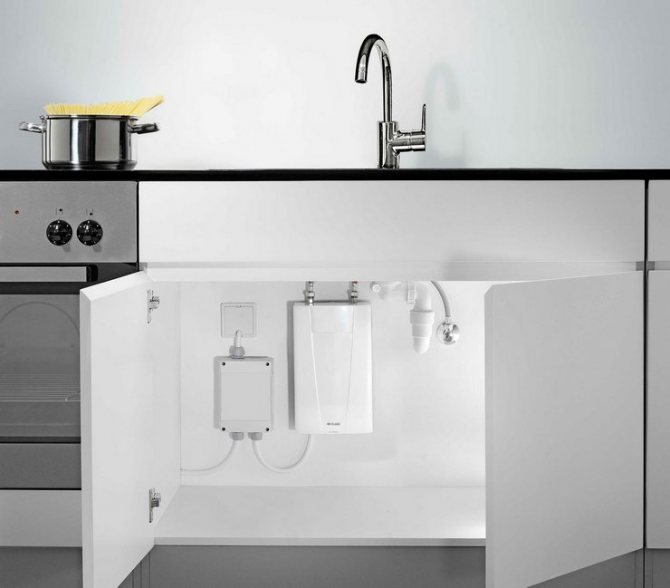

Advantages of instantaneous water heaters:
- financial availability;
- unpretentiousness to the installation;
- compactness and light weight;
- the ability to instantly give a warm stream of water and the absence of a limit on its volume;
- do not need energy consumption when the tap is off;
- efficiency and economy.
Minuses
Cons can be considered:
- a small head of a hot stream for low-power devices;
- demanding power of wiring;
- the probability of a difference in water temperature up to 20 degrees at different times of the year.
Storage water heater
Such systems can most often be found both in country houses and in apartments. In this case, water is drawn into a tank, the volume of which can range from 30 (for the kitchen from 5 liters) to 210 liters. Inside the unit there is a dry (heating element does not come into contact with water) or wet (heating element in contact with water) type heating element, which heats the entire volume of liquid. As soon as the water cools down, the boiler heats it up again. As a result, you can not only wash the dishes, but also take a full shower and bath.
Helpful! It is worth choosing a model with a dry type heating element, since such boilers are more durable.
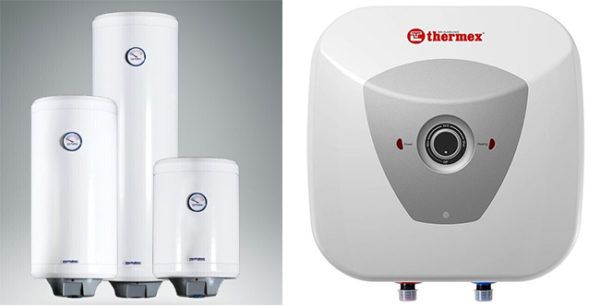

Appliances of this type are valued for their low energy consumption. However, such systems require periodic maintenance and are more expensive. Another drawback is heat loss. Even if you purchase the most modern case, the heat energy will "go away" a little.
Helpful! Some people solve this problem by turning on the boiler a few hours before showering and turning it off after bathing. However, in this case, you will not be able to spontaneously take a bath.
Storage water heaters come in a variety of shapes and types of installation: oval, flat, square, wall, floor, horizontal. Thanks to this, you can choose a model even for the most modest room.
Area of use of the storage water heater
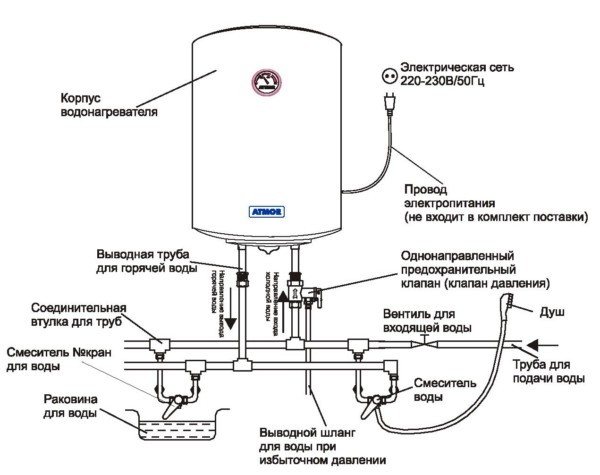

Electric water heater operation diagram.
The use of a storage water heater allows you to solve such a problem as ensuring uninterrupted supply of hot water, which is often necessary not only for a private house, but also for a city apartment. In this case, the use of flow-through systems is ineffective, and if there are several draw-off points, then it is best to use heaters with tanks, the power of which corresponds to the stated needs of consumers.
But many are not happy with the other situation. For example, if someone is washing in the bathroom, and at this time a faucet for washing dishes is turned on in the kitchen, then a sharp drop in temperature is immediately observed. The situation can be corrected by installing an indirect type water heater.
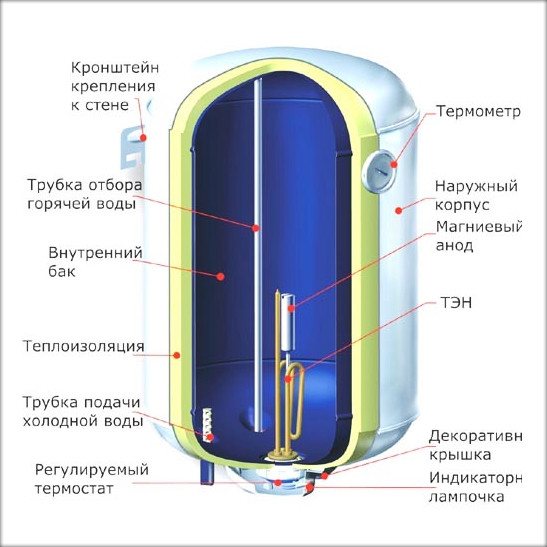

Water heater device diagram.
What volume of a water heater should be
Boilers for 5-10 liters are usually used only for the kitchen. That is, they will only be enough to wash your hands and dishes. For the bathroom, it is worth choosing models from 30 liters. This volume is enough for one person. For two, 50 liters is enough. But if guests come to you, then someone will have to wait while the boiler heats up the next batch of water.
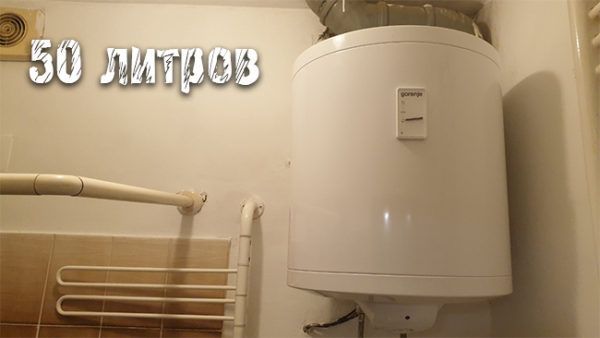

80-100 liters is enough for a family with children, plus you can wash dishes. Large 150 liter boilers are not so popular. Such models are used to connect to a larger number of water intake points. Well, the largest water heaters, with a volume of more than 200 liters, can serve several families. But in addition to the volume, it is worth clarifying other characteristics.
What is the difference between a boiler and a water heater?
A boiler is a container that stores hot water, which is heated by a heat source. The body is made of metal or plastic. The inside of the tank is made of stainless steel or enamelled metal.
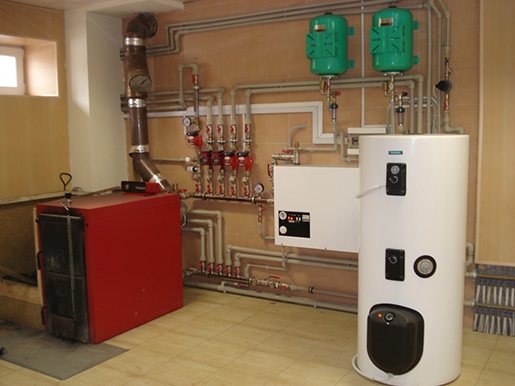

There is a heat-insulating material between the body and the container to reduce heat losses. The main thing to the question of how a boiler differs from a storage water heater - I will answer this way. There is no difference. Because they are one and the same apparatus.
That is, any storage heater is essentially a boiler.
Water heaters are of several types and differ in the way of heating:
- Direct - the heating element is located inside or directly under the tank. They are gas and electric, they can also work from solar panels.
- Indirect - the liquid inside the tank is heated using a heat exchanger, it is most often performed in the form of a coil made of brass or steel, through which the coolant flows from the boiler. The more turns the coil has, the faster the liquid will heat up.

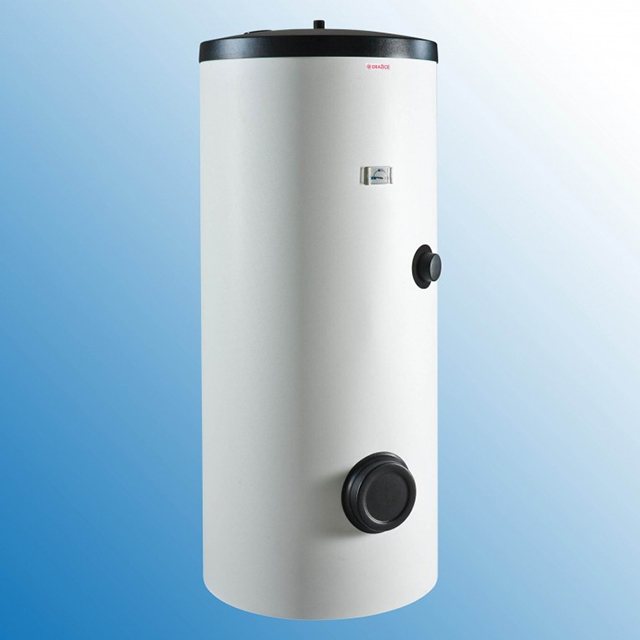
Indirect heating boiler
Structurally, it is located in the lower part of the tank, since cold water, according to the laws of physics, heats up and goes down. This design allows you to quickly bring the temperature to the required value inside the container.
In some models of this type, there are several heat exchangers, there is a "tank in a tank" design, with such a device the wall between the vessels is the heat exchanger.
All units of this type are connected to the boiler by a pipeline through which the coolant flows. Indirect is one of the most economical options for storage units.
Characteristic differences are rather large dimensions and weight, requires a lot of space for installation, have a fairly high cost, the advantages include the absence of dependence on the pressure in the water supply system, and simple installation. The installation method can be either wall-mounted or floor-standing, depending on the model and volume of the tank.
A flow-through water heater, unlike a boiler, has a small size, since it does not have a tank for accumulating liquid, and does not require much space for installation. Cold water is brought to the required temperature by passing through a heating device, which can be a gas burner or heating element.
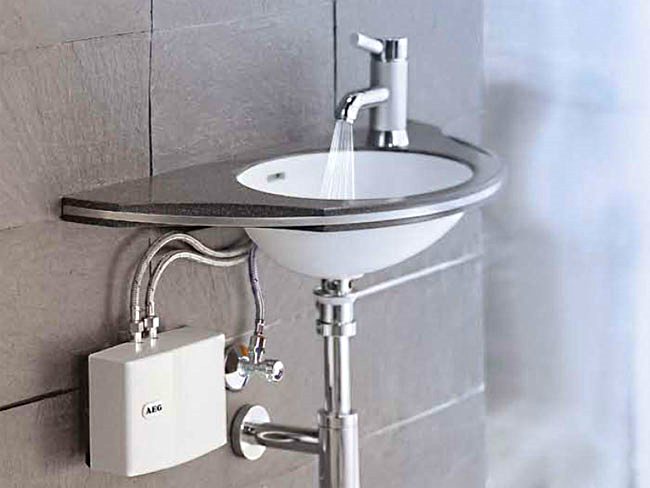

Instantaneous water heater
Heating occurs in a short time in an unlimited volume, when the tap is opened. There are gravity and pressure, pressure can serve several points of water intake and are installed on a riser, only one gravity. Their cost is lower than that of accumulative ones. To install an electric water heater, a separate line with a separate machine is required, since they have a sufficiently large capacity.
To install a gas flow pipe, a package of documents and the presence of a chimney are required, depending on the pressure in the water main. According to the method of installation, they are mainly wall-mounted. The inconvenience in operation is the change in outlet temperature when several water points are turned on in turn.
Boiler options
Standard models usually have thermal limiters, but otherwise they work in automatic mode. The user only selects the heating intensity. But if you prefer flowing models, then you need to make sure that they are also equipped with a child lock.
Important! You cannot purchase an instantaneous water heater that is not equipped with temperature controllers and sensors. Otherwise, the risk is quite high that someone in the household will get burned.
You can also save on electricity if the water heater is capable of operating in ECO mode. In this case, it is not necessary to turn it off, since the unit will independently try to reduce energy consumption.
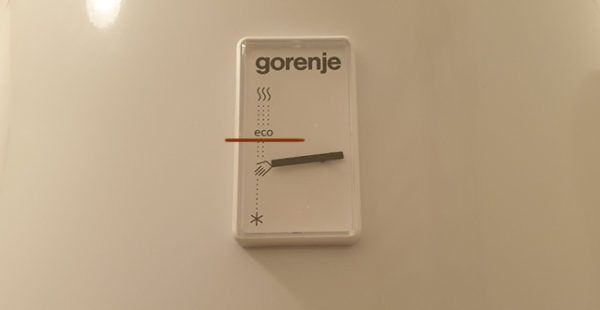

There are more expensive models with a remote control on sale. This option should be used if you plan to install the equipment in a hard-to-reach place (for example, in a closed niche).
Comparison
The equipment of these varieties is used in the discussed supply systems most often. In fact, a boiler is also a variation of a water heater. However, unlike other devices of a similar purpose, it is equipped with a reservoir. The tank is usually relatively small. But there are also samples with a very impressive capacity, containing hundreds of liters of liquid.
The water in the boiler can be heated directly from the built-in heating element or other energy sources. In addition, indirect units are often installed, operating with a heat exchanger. The difference between a boiler and a flow-through type water heater is that here it is necessary to wait for some time to obtain the desired result.
Meanwhile, the flow-through device begins to supply hot liquid already when the tap is opened. In this case, there is no storage capacity. Water is simply passed through the heating element, and there is no limitation in its flow. But the disadvantage here is the high energy consumption when the device is turned on. As a rule, to use such equipment, a separate power supply line must be installed.
Many see the advantage of the "flute" in its compactness. Indeed, for its installation, you do not need to allocate a lot of space, which is important if the area of \ u200b \ u200bthe room is small. But it should be borne in mind that such water heaters are demanding on the water pressure in the system. Therefore, on the upper floors of large houses, their capabilities may be limited. The operation of equipment with a storage tank does not depend on the head force.
Considering what is the difference between a boiler and a water heater, let us dwell on some more nuances. So, if you want to use a flow-through device, you need to know that every time part of the cold water will go to waste until hot water flows. In addition, the temperature of the fluid can vary under conditions of variable head. The boiler in this sense is more convenient. Such a massive device is also preferable when it is required to supply water to more than one point. But you need to fix it thoroughly on a very reliable surface.
Moisture protection class
Since the unit will be in a humid environment, you need to make sure that its housing is securely protected. Therefore, it is worth paying attention to such markings as IP31. As a rule, the first number indicates how well the product is protected from the ingress of foreign objects:
- If the number 1 is indicated immediately after the letters IP, then this indicates that the unit is resistant to large objects the size of a palm.
- 2 - resistant to smaller objects, no more than a finger.
- 3 - small particles of no more than 1 mm2 cannot enter the housing.
- 4 - the case is reliably protected even from dust.
The second number will tell how the case is protected from moisture:
- 0 - the product is not protected from water in any way.
- 1 - the boiler body is resistant only to top leaks.
- 2 - splashes flying at an angle of 60 degrees cannot enter the water heater.
- 3 - reliable protection against splashes from any angle.
- 4 - water will not penetrate into the housing, even if you direct a stream from the shower at it.
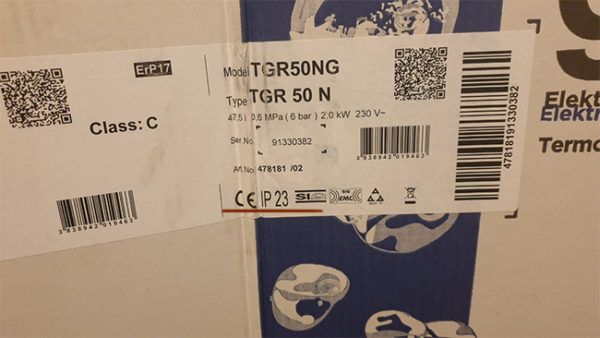

Differences between a boiler and a water heater.
“What is the structural difference between an indirect heating boiler and a storage water heater?” This is a very popular question. Now we will give a detailed and detailed answer to it. Structurally, the boiler is more complex than the water heater. And it gives more opportunities for organizing a comfortable hot water supply.
The differences between a boiler and a water heater will be as follows:
- The boiler can be used to recirculate hot water.
- A boiler heats up the same volume of water much faster than a storage water heater.
- The boiler allows you to organize a hot water supply system with a high simultaneous flow rate and at points of analysis far apart from each other. A storage water heater or instantaneous water heater can provide only one maximum of two parsing points close in distance with a small simultaneous flow.
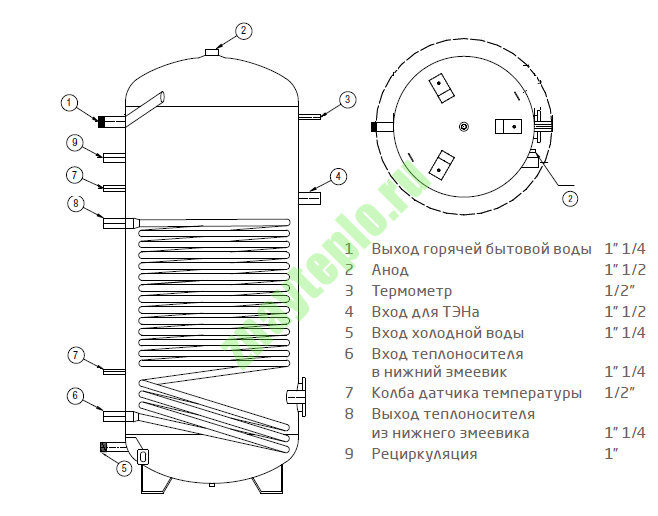

Internal structure of the indirect heating boiler
How does a boiler heat water?
The water inside the boiler is heated either by a coil or by a tank-in-tank system. The power that the coil gives off is much greater than the power of the heating element inside the storage water heater. So, for example, for a boiler with a volume of 100 liters, the power of the coil can reach 30 kW. This allows you to greatly reduce the heating time of the water. There can be 1 or even 2 coils. It depends on the volume of the tank for heating the water.
What is water recycling for?
The hot water recirculation system in the boiler allows not only to increase the total amount of hot water in the system, but also helps to save it. The savings here are as follows:
- You save on water treatment. Often, preparing water for a private house is expensive, and without recirculation, you just have to drain the prepared, but cold water into the sewer.
- You save on pumping out the drain pit - the less water you pour out, the less often you need to pump it out of the pit. This saves you time and money.
Water recirculation pump installation diagram
Tank material
First of all, it should be noted that the internal tank is not intended to be repaired. However, there is no way in the store to see what it looks like. But on the other hand, you can determine the quality of the material based on the warranty period for the water heater:
- From 1 to 5 years (very rarely reaches 7). Most likely, the inner tank is enamelled. This is not the best option.
- 5 to 10 years old. Stainless steel can boast of such indicators. This is the preferred option.
Helpful! Also, some manufacturers write that the inner tank is made of bio-glass porcelain. In fact, it is glass enamel with a prettier name coined by resourceful marketers.
On the outside, the case is usually made of steel and painted white. External parameters are not related to the operation of the unit, so you can choose to your taste.
Storage water heater: principle of operation
A distinctive feature of the storage heater (boiler) is the presence of a reservoir in which a constant water temperature is maintained. If we talk about the constructional device, it is quite simple. The unit consists of:
- internal tank:
- ten;
- thermostat;
- external heat-insulated casing.
Installation of the water heater is carried out on the wall. Powerful anchors or screws are used as fasteners. At the entrance, it is connected to the cold water supply system, at the exit to the internal distribution system of the heated liquid. There is another option, providing for the supply of heated water directly to the end consumer - a shower or a sink.
Due to the tubular electric heater (ten), the switched on device heats the water inside the tank to a predetermined temperature value. As soon as the set level is reached, the thermostat is triggered and the heating process is interrupted.
When deciding on the capacity of the tank, you need to focus on the planned consumption. So, for a family of 2 people, a boiler with a volume of 70-100 liters will be enough. For suburban multi-room cottages with a local water supply system, it would be more rational to stop at a unit with a capacity of 200-250 liters.
As for the power, it is rather modest for storage water heaters. In general, this figure depends on the volume and can range from 5 to 6 kW. For example, for devices with an average capacity (per 100 liters), its value is 2-3 kW. Therefore, an ordinary outlet with standard electrical wiring, with a cable cross-section of 2.5 sq. Will be enough for them. mm.
pros
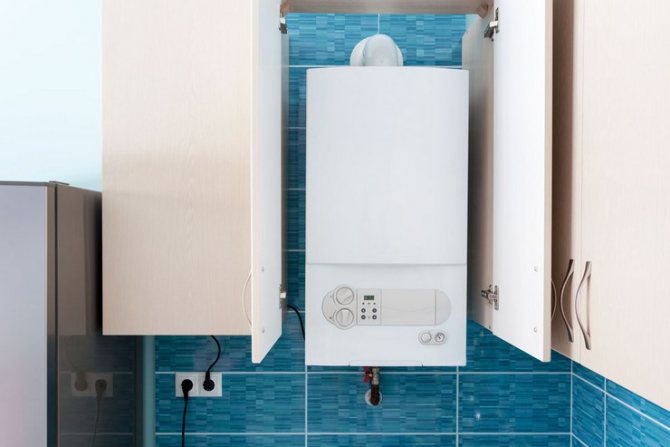

The advantages of these units are:
- wider area of use;
- no special requirements for the network;
- the ability to heat an impressive volume of water, which allows you to meet the needs of a large number of users;
- unpretentiousness to pressure;
- the ability to heat water to higher temperatures;
- the ability to use hot water for some time after a power outage;
- the ability to maintain the temperature of the water in the tank for a long time;
- the supplied water will always have the same degree of heating, its temperature will not depend on the season.
Minuses
Storage heaters also have disadvantages:
- bulkiness and massiveness;
- lower service life, especially if the tank is always full;
- high power consumption;
- exactingness to installation (require the presence of a reliable support structure that can withstand significant loads);
- inability to provide instant hot flow;
- the ability to heat only a limited amount of water equal to the capacity of the tank (then the accumulator takes time to prepare the next portion);
- high cost.
Productivity and water consumption
These parameters depend on how intensively you plan to operate the boiler. For example,:
- If you choose a water heater only for washing dishes or hands, then 2-4 l / min is sufficient.
- For the operation of the shower cabin, 4-8 l / min is more than enough.
- To take a bath, you will need a higher power unit, producing about 8-10 l / min.
- To service several rooms at once, it is indefinable to determine the room with the highest water consumption and multiply the resulting figures by 1.5.
Extra options
There are a few more things to look out for when choosing a water heater:
- Maximum temperature. As a rule, storage-type heaters heat water up to 60-85 degrees. But don't assume that the higher the number, the better. The fact is that at temperatures above 60 degrees, scale begins to form. This means that the unit will fail faster. The best option is a model in which you can independently set the maximum temperature threshold and set it to 55 degrees (boilers with “Eco” mode also adhere to this temperature).
- Built-in RCD. Since we are talking about electricity and water, you need to protect yourself. The RCD will prevent possible electric shock if the water heater fails. Such systems are installed in the models of the most popular manufacturers (Ariston, Polaris, Gorenje, Electrolux and others).
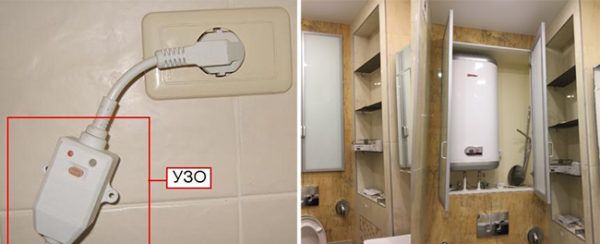

- Frost protection. This option is very relevant for a changeable climate, especially if the boiler is installed in a country house. It is best to purchase a model that will not allow the water temperature to drop below +6 degrees. If this happens, the unit will turn on by itself and heat the water to the required +10 degrees.
There are also a few more tips to consider.
Types of boilers that exist today
The main types by the method of heating water:
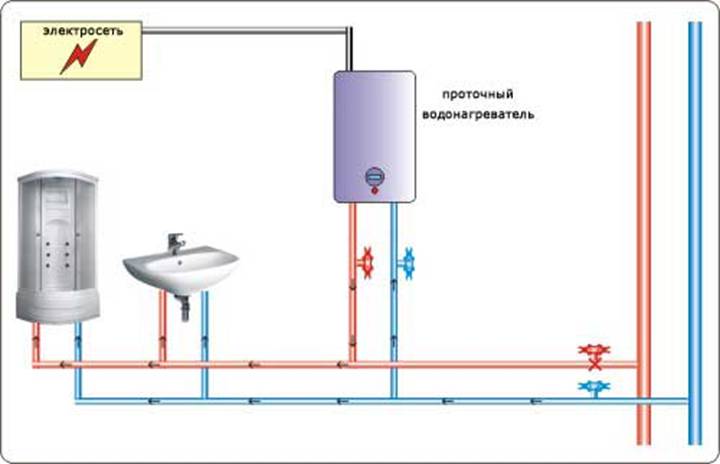

Installation diagram of an instantaneous water heater.
- electrical;
- gas: with an open combustion chamber (using natural draft); with a closed combustion chamber (using forced draft);
- indirect heating (those that use the power of the boiler);
- combined - using gas and electricity.
By the way of water supply:
- pressure head;
- non-pressure (can be used in the absence of water supply).
By installation method:
- floor;
- suspended (subdivided into vertical and horizontal).
By the shape of the tank:
- round (in the form of a cylinder);
- oval (in the form of an oval rectangle);
- other forms.
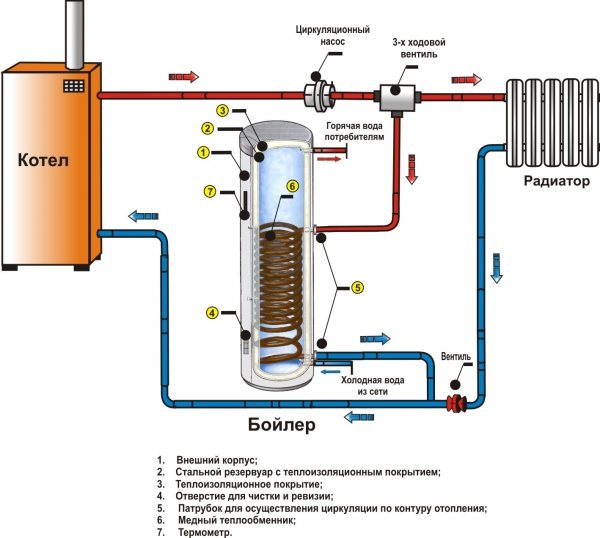

Diagram of an indirect heating boiler.
An electric boiler consists of a metal tank, a heating element (thermal electric heater), a magnesium anode and a thermostat. The magnesium anode serves to protect against corrosion inside the tank. The outside surface of the tank is covered with a layer of heat-insulating material. Additional items may be present depending on the model.
Principle of operation: The heating element, placed inside the tank, heats the water. Cold water is supplied from the bottom, hot water is discharged from the top. The pressure in the water supply system pushes the heated water, and it enters the points of use. The thermostat controls the water temperature (the user sets this parameter himself, changing it if necessary), heating the water to the set value and maintaining the temperature by turning the heating element on and off.
Related article: How to glue liquid wallpaper: preparation, progress of work (video)
The advantages of an electric water heater are: lower cost, ease of installation, no need for a chimney, the ability to install in any convenient place, even under the ceiling (suspended horizontal boilers are designed just for this).
The electric boiler is connected to the household power supply, so it is convenient to use it in the house, in the apartment, in the country, in small businesses for household purposes.
Gas boiler. The principle of operation is the same as that of an electric one, only water is heated from a gas burner.
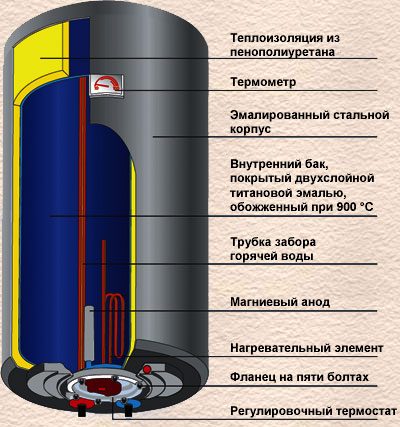

Wiring diagram for connecting the boiler.
To install it, you need to make an additional outlet into the chimney, and this complicates the installation and affects the location of the device. A boiler with a closed combustion chamber (using forced draft) can be installed against an external wall with the exhaust of combustion products through a special hole in it.
Advantages: with a higher purchase and installation cost, a gas boiler is cheaper during operation, since the price of gas is much lower than that of electricity. Another advantage is high power compared to electric. This allows you to quickly heat the water to the desired temperature, so a slightly smaller boiler can be purchased for the same needs. Disadvantages: arbitrary placement is impossible, additional documentation is needed for installation, and the main one - gas is not available everywhere.
Indirect heating boiler. Can be used in addition to a single-circuit boiler. The cylinder-shaped container can be installed vertically or horizontally depending on the model. A heat exchanger tube is placed inside the container, which has a complex shape (usually serpentine). A coolant circulates through this pipe, which heats the water.
There are models without heat exchanger tubes. Such a boiler consists of two vessels inserted one into the other. Heated water is in the inner vessel, and the heat carrier circulates in the outer one.
Principle of operation: cold water enters the tank of the boiler through the inlet, in the coil of the heat exchanger or between the double walls of the casing circulates a heat-transfer fluid heated by the heating boiler. It heats up the incoming water in the boiler and maintains it at a constant temperature. Each indirect heating boiler has inlet and outlet pipes connecting it to the heating boiler, and hot water is supplied to the consumer through the outlet pipe.
Related article: DIY solar water heater
Advantages:
- high performance;
- the heat transfer fluid is specially prepared, thereby reducing its negative impact on the heat exchanger;
- you can use various sources of thermal energy, as well as switch from one to another if necessary (there are models of boilers with built-in heating elements).
Disadvantages:
- high cost of equipment and installation (it is necessary to invite specialists);
- when heating a large volume of water, less heat is supplied for heating;
- installation must be carried out in a special room (boiler room).
Features of choosing a boiler
Before buying a water heater for a country house, you should consult with an electrician. The fact is that the water heating system requires a separate line. Accordingly, you need to determine how much power is generally allocated to the house. For example, if you live in an old house with 16A plugs, then you cannot choose a boiler with a power higher than 3.5 kW. Accordingly, the instantaneous water heater will most likely not be able to be installed.
If we are talking about a new building, then plugs at 32-40A can be installed in it. This means that a boiler with a capacity of no more than 6 kW can be installed in such a house.
It is also worth taking care of accounting for the working pressure. In some models, sensors are installed that do not react in any way if the water supply is too weak. Despite the fact that most modern water heaters operate at 0.5 bar, it is recommended to take this nuance into account.
Of course, before buying a boiler, you need to decide exactly where it will be installed. Based on this, it will be easier to determine the dimensions and shape of the product body. Also, preference should be given to trusted manufacturers.
Features of instantaneous and storage water heaters
Most ordinary and not so ordinary citizens who decide to provide their homes with hot water all year round, do this with the help of a storage heater or boiler. It is a sealed reservoir (most often cylindrical), in which a certain volume of water is concentrated. In addition, there is an electric heating element inside the tank, which, under automatic control, heats the water to a predetermined temperature and keeps it at this level.
Such a device allows access to hot water at any time, only its amount will be limited by the volume of the tank. That is, if you use it at once, for example, filling the bathroom, then cold water will enter the tank and you will have to wait some time (from 1 to 3 hours) for its temperature to reach the set value.
An alternative to storage boilers are flow-through. They allow you to instantly get unlimited hot water. To achieve this effect, an insulated tank must contain either a powerful electric heating element or a gas burner device with a high-speed compact heat exchanger. In the latter case, it makes sense to talk not about the boiler, as such, but about the usual gas water heater.
In addition to the obvious advantages, heaters of this group have no less obvious disadvantages:
- Firstly, in order to quickly heat a large volume of running water, you will have to spend either a lot of electricity (when the heating element is operating) or natural gas. Accordingly, there will be a serious burden on the family budget;
- Secondly, it will be necessary to modernize or equip a new, sufficient power supply network or gas pipeline, and this also requires serious capital investments and work;
- Third, any of the flow heaters need periodic maintenance to prolong the life and ensure the safety of the equipment.
Best water heaters
In short, users distinguish several models of different types:
- Electrolux Smartfix 2.0 6.5 TS. Compact instantaneous water heater with a stainless steel tank costing about 2,600 rubles. It heats water up to 80 degrees. The power is 6.5 kW. The unit is equipped with a thermostat. Suitable in case of a sudden water cutoff.
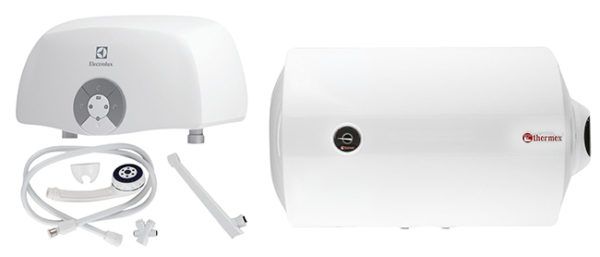

- THERMEX ERS 80 H Silverheat. This is a horizontal storage water heater. The inner tank is made of bioglass porcelain. The maximum heating temperature is 75 degrees. The unit is equipped with an RCD, thermometer and indicators. It costs about 8,500 rubles.
- Stiebel Eltron HFA / EB 80 Z. One of the highest quality, but also expensive water heaters. It costs more than 100,000 rubles. But this storage unit is equipped with everything you need. It has a copper heating element and a replaceable magnetic anode. The tank itself is thermally insulated, there is a quick heating option.
Similar publications:
Choosing a water heater - flow or storage?
Who of our compatriots, at least once in their life, has not experienced the discomfort caused by the disgusting work of housing maintenance enterprises. Their constant accidents, preventive shutdowns and interruptions in the supply of hot water force, sooner or later, to think about purchasing alternative sources of hot water supply.
Electric water heaters are the most popular in our country. This is due to their low cost and ease of installation.
According to the heating principle, all water heaters are divided into flow and storage.
What is the difference between them?
Simply put, a storage water heater is a large electric kettle.When it heats the water to the required temperature, you can use it.
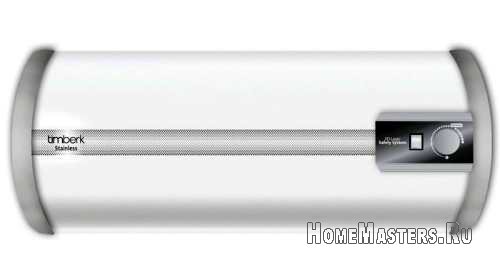

In a flow-through heater, water, running through powerful heating elements (heating elements), takes heat from them and flows out of the tap already warmed up.
Let's try to compare each type of water heater according to the characteristics that are important for the consumer.
1.Energy consumption or, in other words, efficiency.
At first glance, it seems that instantaneous water heaters, having powerful heating elements, should consume much more electricity than storage ones. However, it is not. They just consume it in a relatively short period of time, and accumulative ones stretch energy consumption over time. The total amount of electricity spent on heating water is comparable in size.
2. Dimensions and weight.


